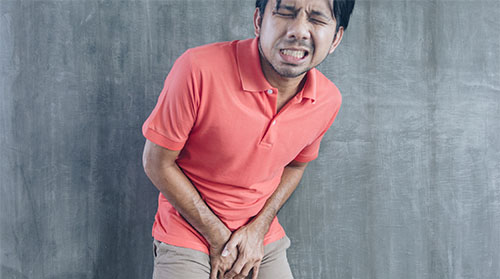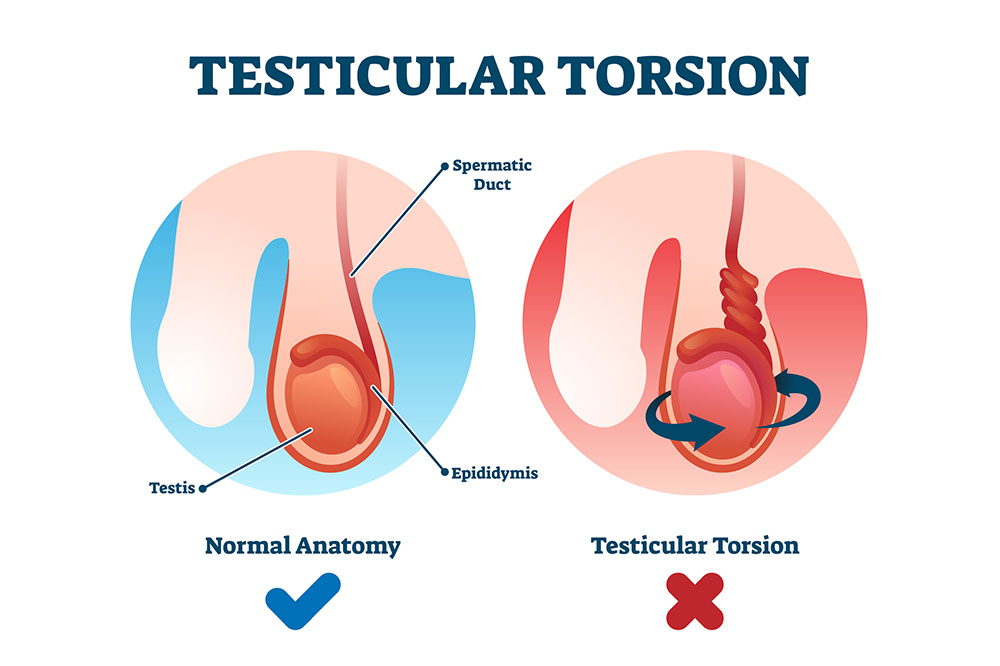
A man with a pained expression holding his testicles with both hands
What is testicular torsion?
Most people know what testicles are. But did you know that each testicle is connected to the rest of the body by a leash of vessels called the spermatic cord?
Because the testicles hang from this cord, it's possible they can twist around inside the scrotum and cut off their own blood supply. This is called testicular torsion.
If testicular torsion occurs, it requires urgent medical attention.
What causes testicular torsion and who is at risk?
Testicular torsion can happen to boys and men of any age, but most cases occur in boys between the ages of 12 and 18.
While it’s not always known what causes torsion, some boys have what are called ‘bell-clapper testes’, where the attachments to the spermatic cord are a little bit higher than normal, making the testicle more mobile. This means the testicle can twist on itself and then not be able to twist back. We don't yet know why some boys have higher attachments and others have lower attachments, and it’s not possible for a regular person to tell from the outside if a boy has this longer cord or not.
Testicular torsion can happen at any time. It might happen when a person is sleeping, sitting on the couch, or it could happen after playing sports or exercising. Torsion can also happen after there has been trauma to the testicles, like a bump or blow. You can find more information in this Children’s Health Queensland fact sheet.

Symptoms of testicular torsion
The most common symptom of testicular torsion is pain in the testicles. If you or your child or teen experiences a sudden pain in their scrotum or one of their testicles, they need to seek medical attention immediately. When asking them about the pain, it’s important to note that although the pain might come and go, if it’s torsion, it generally won’t go away completely.
The following symptoms can indicate a testicular torsion:
- pain in the testicles and/or the lower abdomen on the same side
- one testicle appears to be higher than the other
- nausea and vomiting.
It is vital that boys and men know that pain in their testicles could be a sign of testicular torsion. If you notice your child or teen experiencing these symptoms, they should head to the hospital straight away.
How is testicular torsion treated?
The only treatment for testicular torsion is an urgent operation.
When you arrive at the hospital, a doctor will need to look at the scrotum, testicles and lower abdomen. It may be embarrassing for your child or teen to go through an examination – but you can reassure them that the doctors know what they are doing and are there to help them feel better.
After the examination, if testicular torsion is diagnosed, the doctor may perform surgery straight away.
You can expect your child or teen to be taken into an operating theatre and given a general anaesthetic for the operation. Children's Health Queensland has some great resources on how to prepare your child for a hospital visit.
During the operation, a surgeon will untwist the spermatic cord through an incision in the scrotum. They will then stitch the testicle inside the scrotum to prevent it happening again. After the scrotum has been stitched back up, your child or teen will be taken to a recovery room. You will most likely get a call from a nurse when they have been moved, so you can be with your child as they wake up.
The surgery itself is usually over and done within 30-45 minutes and your child or teen can usually go home by the next day.
Recovery
After surgery for testicular torsion, there will be bruising and swelling for about a week or so. The good news is dissolvable stitches are usually used, so there is no need for removal.
Your child or teen will be able to go back to normal activities, including attending school, in about 1-2 weeks. Strenuous activities (like sports) can usually be picked up about 2-3 weeks after the operation, subject to the go ahead of your doctor.
It’s important to keep in touch with your child’s treating team who will provide you with information to help with healing and recovery.
Tips to talk to your child/teenager about identifying health issues
We know it’s not easy talking to your child or teen about health issues, particularly when you are talking about reproductive organs!
But while it can be embarrassing to begin with, it is important to have these conversations.
Before you start the conversation, it’s a good idea to prepare yourself and do your research. Always refer to the body parts using the correct words (for example, ‘testicles’ and ‘penis’, rather than ‘balls’ and ‘willy’) and encourage questions. Try to make your child feel comfortable with the conversation, so they know it’s normal to come to you if they do notice a problem in the future. If you are having trouble, there are trusted sources online which can be accessed to help you navigate these conversations. Body Talk has some amazing resources to support you along this journey.